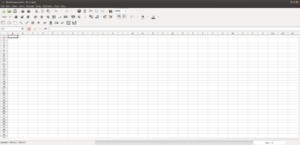Gnumeric
Gnumeric is a spreadsheet program that is part of the GNOME Free Software Desktop Project. Gnumeric version 1.0 was released on 31 December 2001. Gnumeric is distributed as free software under the GNU GPL license; it is intended to replace proprietary spreadsheet programs like Microsoft Excel. Gnumeric was created and developed by Miguel de Icaza,[3] but he has since moved on to other projects. The maintainer as of 2002 was Jody Goldberg.[4]
 | |
 A screenshot of Gnumeric 1.12.9 running under Ubuntu MATE | |
| Original author(s) | Miguel de Icaza |
|---|---|
| Developer(s) | The GNOME Project |
| Initial release | 31 December 2001 |
| Stable release | 1.12.47 (10 May 2020[1]) [±] |
| Preview release | None [±] |
| Repository | |
| Written in | C |
| Operating system | Unix-like |
| Platform | GTK 3 |
| Type | Spreadsheet |
| License | GPLv2 or GPLv3[2] |
| Website | gnumeric |
Features
Gnumeric has the ability to import and export data in several file formats, including CSV, Microsoft Excel (write support for the more recent .xlsx format is incomplete[5]), Microsoft Works spreadsheets (.wks),[6] HTML, LaTeX, Lotus 1-2-3, OpenDocument and Quattro Pro; its native format is the Gnumeric file format (.gnm or .gnumeric), an XML file compressed with gzip.[7] It includes all of the spreadsheet functions of the North American edition of Microsoft Excel and many functions unique to Gnumeric. Pivot tables and Visual Basic for Applications macros are not yet supported.[8]
Gnumeric's accuracy has helped it to establish a niche for statistical analysis and other scientific tasks.[9][10] For improving the accuracy of Gnumeric, the developers are cooperating with the R Project.
Gnumeric has an interface for the creation and editing of graphs different from other spreadsheet software. For editing a graph, Gnumeric displays a window where all the elements of the graph are listed. Other spreadsheet programs typically require the user to select the individual elements of the graph in the graph itself in order to edit them.
Gnumeric under Microsoft Windows
Gnumeric releases were ported to Microsoft Windows until August 2014 (the latest versions were 1.10.16 and 1.12.17).[11]
Use of current version of Gnumeric on Windows is possible with MSYS2 with experienced know-how of a Linux/Unix user. After GTK+ 2.24.10 and 3.6.4, development of Windows version was closed by GNOME. Creation of Windows version was complicated by bugs in old Windows versions of GTK+.
Installation of MSYS2 on Windows is a good way to use current GTK software.[12] GTK+ 2.24.10 and 3.6.4 are available on-line.[13][14] Versions of GTK for 64-bit Windows are prepared by Tom Schoonjans – current examples are 2.24.32 and 3.24.12.[15] This could be also a new start for a new native 64-bit Windows version of Gnumeric.
A new way is the new Windows Subsystem for Linux (WSL) on Windows 10 Release 1709 and later. After installing a Linux distribution like Ubuntu, Debian or SUSE from Microsoft Store and with an X-Server like Xming, running thousands of applications like Gnumeric directly is possible. sudo apt-get install gnumeric is the right command on Ubuntu.[16]
See also
- EditGrid – was an on-line spreadsheet which used Gnumeric as its back-end
- List of spreadsheet software
- Comparison of spreadsheet software
References
- "Tags - GNOME / gnumeric". Retrieved 10 May 2020.
- COPYING
- "The Gnumeric spreadsheet". Gnumeric. Retrieved 6 September 2010.
Gnumeric has been coded mainly by Miguel de Icaza, with help from other intrepid hackers that have contributed code, bug fixes and documentation.
- Rick Lehrbaum (11 January 2002). "DesktopLinux.com interviews Gnumeric project leader Jody Goldberg". desktoplinux.com archive. Archived from the original on 7 February 2013. Retrieved 26 April 2017.
- Gnumeric v1.10 manual, file formats
- The file formats which Gnumeric can read. Projects.gnome.org. Retrieved on 2013-12-09.
- "Gnumeric XML File Format". The Gnumeric Manual, version 1.8. GNOME Documentation Project. November 2007. Retrieved 31 January 2010.
- "Things we plan to do in Gnumeric". Gnumeric. Retrieved 3 January 2013.
- McCullough, B. D. (4 June 2004). "Fixing Statistical Errors in Spreadsheet Software: The Cases of Gnumeric and Excel" (PDF). Computational Statistics & Data Analysis. Archived from the original (PDF) on 23 April 2009. Retrieved 31 January 2010.
The most recent versions given a full analysis in this report (available without charge) are Microsoft Excel XP and Gnumeric 1.1.2, and the author has more-limited data on then-new Excel 2003.
- McCullough, B. D.; Wilson, Berry (15 June 2005). "On the accuracy of statistical procedures in Microsoft Excel 2003" (PDF). Computational Statistics & Data Analysis. 49 (4): 1244–1252. CiteSeerX 10.1.1.455.5508. doi:10.1016/j.csda.2004.06.016. ISSN 0167-9473. Retrieved 31 January 2010.
In this journal article, after a more complete analysis of Excel 2003, McCullough concludes that Excel 2003 is an improvement over previous versions, but not enough has been done that its use for statistical purposes can be recommended
- Morten Welinder (25 August 2014). "Discontinuing Windows Builds". Comments.gmane.org. Archived from the original on 21 December 2016. Retrieved 9 December 2016.
- https://www.gtk.org/download/windows.php
- https://sourceforge.net/projects/gtk-win/
- http://www.tarnyko.net/dl/gtk.htm
- https://github.com/tschoonj/GTK-for-Windows-Runtime-Environment-Installer
- https://carlomonjaraztec.wordpress.com/2017/07/10/ccx_in_win10/
External links
| Wikimedia Commons has media related to Gnumeric. |
- Official website
- Gnumeric XML File Format
- Open Mag interviews Jody Goldberg on Gnumeric. Nancy Cohen, 17 February 2004; archived 2012
- Linux Productivity Magazine Volume 2 Issue 6, June 2003: full issue on Introduction to Gnumeric
